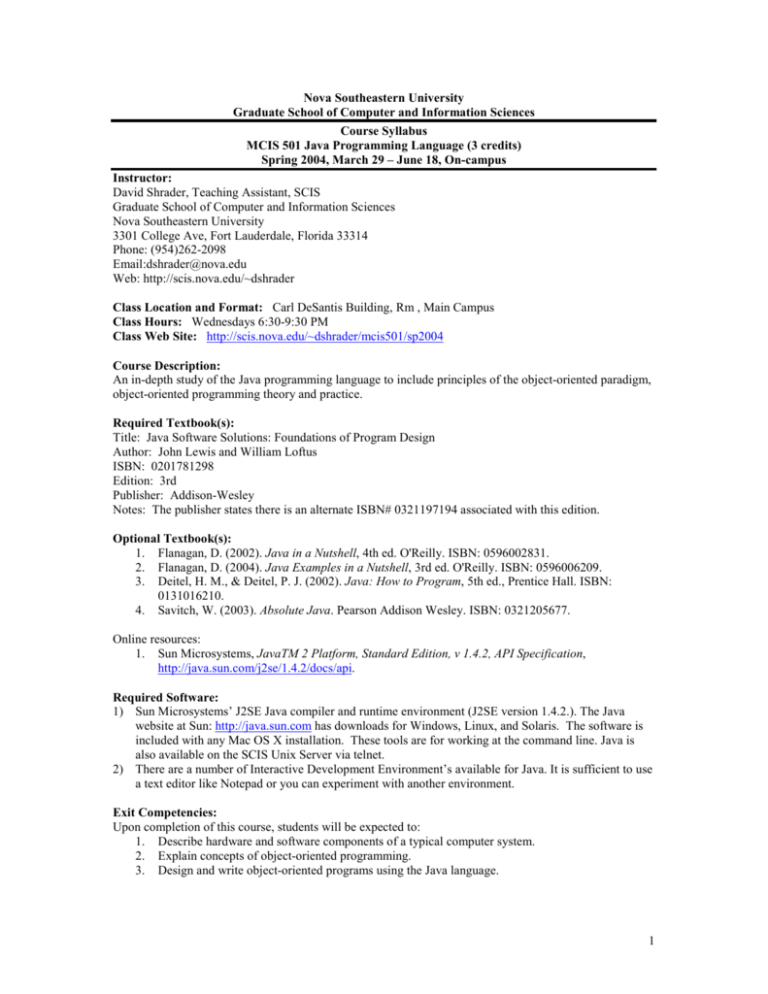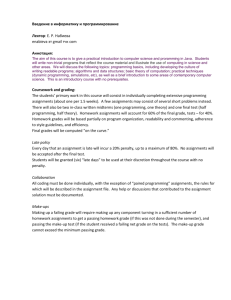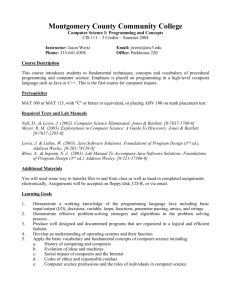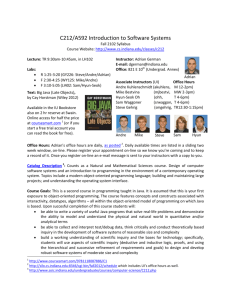
Nova Southeastern University
Graduate School of Computer and Information Sciences
Course Syllabus
MCIS 501 Java Programming Language (3 credits)
Spring 2004, March 29 – June 18, On-campus
Instructor:
David Shrader, Teaching Assistant, SCIS
Graduate School of Computer and Information Sciences
Nova Southeastern University
3301 College Ave, Fort Lauderdale, Florida 33314
Phone: (954)262-2098
Email:dshrader@nova.edu
Web: http://scis.nova.edu/~dshrader
Class Location and Format: Carl DeSantis Building, Rm , Main Campus
Class Hours: Wednesdays 6:30-9:30 PM
Class Web Site: http://scis.nova.edu/~dshrader/mcis501/sp2004
Course Description:
An in-depth study of the Java programming language to include principles of the object-oriented paradigm,
object-oriented programming theory and practice.
Required Textbook(s):
Title: Java Software Solutions: Foundations of Program Design
Author: John Lewis and William Loftus
ISBN: 0201781298
Edition: 3rd
Publisher: Addison-Wesley
Notes: The publisher states there is an alternate ISBN# 0321197194 associated with this edition.
Optional Textbook(s):
1. Flanagan, D. (2002). Java in a Nutshell, 4th ed. O'Reilly. ISBN: 0596002831.
2. Flanagan, D. (2004). Java Examples in a Nutshell, 3rd ed. O'Reilly. ISBN: 0596006209.
3. Deitel, H. M., & Deitel, P. J. (2002). Java: How to Program, 5th ed., Prentice Hall. ISBN:
0131016210.
4. Savitch, W. (2003). Absolute Java. Pearson Addison Wesley. ISBN: 0321205677.
Online resources:
1. Sun Microsystems, JavaTM 2 Platform, Standard Edition, v 1.4.2, API Specification,
http://java.sun.com/j2se/1.4.2/docs/api.
Required Software:
1) Sun Microsystems’ J2SE Java compiler and runtime environment (J2SE version 1.4.2.). The Java
website at Sun: http://java.sun.com has downloads for Windows, Linux, and Solaris. The software is
included with any Mac OS X installation. These tools are for working at the command line. Java is
also available on the SCIS Unix Server via telnet.
2) There are a number of Interactive Development Environment’s available for Java. It is sufficient to use
a text editor like Notepad or you can experiment with another environment.
Exit Competencies:
Upon completion of this course, students will be expected to:
1. Describe hardware and software components of a typical computer system.
2. Explain concepts of object-oriented programming.
3. Design and write object-oriented programs using the Java language.
1
Course Outline:
1) Computer Systems
2) Objects and Primitive Data
3) Program Statements
4) Writing Classes
5) Enhancing Classes
6) Arrays and ArrayLists
7) Inheritance
8) Exceptions and I/O Streams
9) Graphical User Interfaces
10) Software Engineering
Schedule:
The class meets each Wednesday evening starting March 31, 2004 and ending Wednesday June 16, 2004.
The course will follow the outline as stated above with adjustments as the term progresses.
Instruction Methods and Tools:
The course is taught onsite and will incorporate in-class lectures and practical laboratory examples. Each
student will be required to produce a variety of java programs that will be submitted electronically.
All students will be required to submit assignments via the SCIS ESET system. The ESET system, which
stands for Electronic Student, Electronic Teacher, is a cutting-edge system designed to allow you to submit
assignment documents to your professor in the form of word processor files, spreadsheets, images, or any
requested file type directly from your web browser. In some cases, identified for individual assignments, it
will be acceptable to upload the assignment to the SCIS web server with a URL submitted via ESET.
Grades and feedback for individual assignments will be posted via ESET. In some cases, a marked up paper
copy will be returned if useful for clarifying the feedback.
Students may need to use the SCIS Forums. Forums is an interactive, dynamic web-based tool that
functions much like a bulletin board between students and professor, allowing all students to read each
other’s postings. The Forums provide a means for assistance in the use of development tools, programming
language details, or concept discussions in the intervening time between classes.
Specific instructions will be provided with each assignment.
Assignments:
1. There will be a weekly reading assignment from the textbook.
2. Homework will be assigned most weeks with recommended and required components. Solutions to
each assignment will be discussed on the due dates.
3. Only the required programming assignments are to be submitted to ESET prior to the class period in
which it is due. Paper copies are not accepted and late assignments will NOT BE ACCEPTED.
However, partial credit will be given for incomplete assignments submitted on time. It is recommended
that students bring a copy to class either on paper or on a laptop computer for discussion purposes.
4. Submissions will be graded with feedback via ESET within a week.
Examinations and Quizzes: There will be a midterm exam and a final exam to be taken in class. These
exams will have questions to answer and will also have programming projects to complete (on paper only).
2
Grading Criteria:
Item
6 Required Assignments (with multiple
programming exercises in each)
Midterm Exam
Final Exam
Total
Weight
60 points
15 points
25 points
100 points
A
A-
B+
B
B-
C+
C
C-
F
100-93
92-90
89-87
86-83
82-80
79-77
76-73
72-70
70-0
A student may not do additional work or repeat an examination to raise a final grade.
Programming assignments will be graded for style (50%) as well as correctness (50%). Correctness is
satisfied when your program solves the problem assigned. Style often seems nebulous to a beginning
programmer, but hopefully becomes second nature to a programming veteran. The basic components of
style, as expected in this course, are:
1.
Documentation
Possibly more important than the code itself, documentation is the programmer’s communication
for human readers. The guidelines on page 33 and pages 708-709 of your text are good
guidelines. Of course, remember that documentation is prose, and while occasional abbreviations
are acceptable, misspellings and incorrect grammar are not. Note the section titled Writing Skills
below.
2.
Design
As you write larger and larger programs, more design choices need to be made. Correspondingly,
design issues become more vital in larger programs, otherwise software becomes unmanageable.
Design issues “in the large” involve decisions about what classes will be defined, and what
methods will be provided by those classes. But design issues “in the small” include good
programming habits like avoiding magic numbers, distinguishing constants from variables where
appropriate, using informative variable names, and avoiding redundancy where possible. For
more details, see the “design guidelines” in Appendix G.
3.
Presentation
Many seemingly small points are vital to the readability of your programs. Follow Java
conventions for issues such as capitalization and indentation; let your editor help you where it can.
See also the “style guidelines” section in Appendix G.
Bibliography:
The optional text section above presents a bibliography specific to the Java Programming Language. The
instructor maintains a bibliography for the Java Programming Language available at
http://scis.nova.edu/~dshrader/java.htm and for Object-Oriented Applications available at
http://scis.nova.edu/~dshrader/ooa.htm.
Class/Course Rules:
1. Standards of Academic Integrity (For complete policy, see Code of Student Conduct and Academic
Responsibility, p. 45. Also see the sections on student misconduct, p. 10, and the NSU Student Handbook.)
3
Students are encouraged to discuss the course contents with colleagues in order to gain a better
understanding of the various issues covered. However, all work that you submit must reflect your
individual effort. Any help that you receive must be explicitly acknowledged and all reference material
must be cited.
Each student is responsible for maintaining academic integrity and intellectual honesty in his or her
academic work. It is the policy of the school that each student must:
Submit his or her own work, not that of another person
Not falsify data or records (including admissions materials)
Not engage in cheating (e.g., giving or receiving help during examinations, acquiring and/or
transmitting test questions prior to an examination)
Not receive or give aid on assigned work that requires independent effort
Properly credit the words or ideas of others according to accepted standards for professional
publications.*
Not use term paper writing services or consult such services for the purpose of obtaining
assistance in the preparation of materials to be submitted in courses or for theses or dissertations
Not commit plagiarism (Webster’s defines plagiarism as “stealing or passing off ideas or words of
another as one’s own” and “the use of a created production without crediting the source.”).
When using the exact words of another, quotation marks must be used for short quotations (fewer
than 40 words), and block quotation style must be used for longer quotations. In either case, a
proper citation must also be provided. When paraphrasing (summarizing, rewriting, or
rearranging) the words or ideas of another, a proper citation must be provided. The Publication
Manual of the American Psychological Association, Fifth Edition, contains standards and
examples on quotation methods (pages 117 and 292) and on citation methods (pp. 207–214).
Extreme caution must be exercised by students involved in collaborative work to avoid violation of this
policy.
See Catalog for Policy on Acceptable Use of Computing Resources, and Policy on the Use of Material in
Web Pages.
2. Writing Skills
Each student must demonstrate proficiency in the use of the English language in all work submitted for this
course. Grammatical errors, spelling errors, and writing that does not express ideas clearly will affect your
grade. The professor will not provide remedial help concerning writing problems that you might have.
Students who are unable to write correctly and clearly are urged to contact their program office for sources
of remedial help.
3. Communication by Email
Students must use their NSU email accounts when sending email to faculty and staff and must clearly
identify their names and other appropriate information, e.g., course or program. When communicating with
students via email, faculty and staff members will send mail only to NSU email accounts using NSUrecognized usernames. Students who forward their NSU-generated email to other email accounts do so at
their own risk. SCIS uses various course management tools that use private internal email systems.
Students enrolled in courses using these tools should check both the private internal email system and
4
NSU’s regular email system. NSU offers students Web-based email access. Students are encouraged to
check their NSU email account daily.
4. The Temporary Grade of Incomplete (I)
The temporary grade of Incomplete (I) will be granted only in cases of extreme hardship. Students do not
have a right to an incomplete, which may be granted only when there is evidence of just cause. A student
desiring an incomplete must submit a written appeal to the course professor at least two weeks prior to the
end of the term. In the appeal, the student must: (1) provide a rationale; (2) demonstrate that he/she has
been making a sincere effort to complete the assignments during the term; and (3) explain how all the
possibilities to complete the assignments on time have been exhausted. Should the course professor agree,
an incomplete contract will be prepared by the student and signed by both student and professor. The
incomplete contract must contain a description of the work to be completed and a timetable. The
completion period should be the shortest possible. In no case may the completion date extend beyond 30
days from the last day of the term for master’s courses or beyond 60 days from the last day of the term for
doctoral courses. The incomplete contract will accompany the submission of the professor’s final grade
roster to the program office. The program office will monitor each incomplete contract. If a change-ofgrade form is not submitted by the scheduled completion date, the grade will be changed automatically
from I to F. No student may graduate with an I on his or her record. The grade of I does not apply to
master’s thesis or doctoral dissertation registrations.
5. Grade Policy Regarding Withdrawals
Course withdrawal requests must be submitted to the student’s program office in writing (via postal mail or
email) by the student. Requests for withdrawal must be received by the program office at least three weeks
prior to the last day of the term. Program offices will publish specific withdrawal deadline dates for each
term (see Academic Calendar on page ii of the catalog). Withdrawals sent by email must be sent from the
student's assigned NSU email account. Requests for withdrawal received after 11:59 p.m. est on the
withdrawal deadline date will not be accepted. Failure to attend classes or participate in course activities
will not automatically drop or withdraw a student from the class or the university. Students who have not
withdrawn by the withdrawal deadline will receive letter grades that reflect their performance in the
course(s). When a withdrawal request is approved, the transcript will show a grade of W (Withdrawn) for
the course. Students with a history of withdrawals risk dismissal. Depending on the date of withdrawal, the
student may be eligible for a partial refund. For a complete list of withdrawal deadline dates, please see the
academic calendars located at: http://www.scis.nova.edu/NSS/pdf_documents/AcadCal.pdf
6. Other Course Specific Rules
Please ensure that your name, scis usercode, and phone number are available on each assignment handed
in. This information must also appear on all e-mail messages and attached documents, as well.
Unless otherwise specified, please use the ESET system to submit all your assignments. Even if you do not
use ESET to submit your assignment (i.e., web page) send a note via the ESET system informing me of the
URL at which you have posted the assignment.
You are responsible for ensuring that the file is readable and free of virus.
Acknowledgements:
This course and syllabus are based on the course originally developed by Dr. A. Seagull.
5







